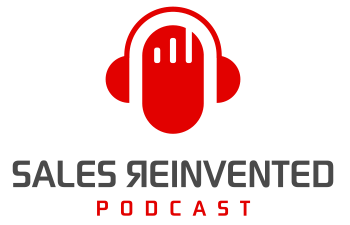Episode #428: Brian Ahearn

Meet
Brian Ahearn
Brian Ahearn is one of only a dozen Cialdini Method Certified Trainers in the world. He’s the founder of Influence PEOPLE, LLC, author of four books, and a faculty member at the prestigious Cialdini Institute.
Our Mission Is To Change The Negative Perception Of Sales People
Our Vision Is A World Where Selling Is A Profession To Be Proud Of
In this episode of Sales Reinvented, Brian Ahearn breaks down how to effectively handle objections, with price being the most common. He explains that salespeople must guide comparisons to demonstrate value, making price less of a hurdle.
Preparation is key—knowing objections in advance and addressing them early builds trust and credibility. Brian shares his “Feel, Felt, Found” technique to handle objections empathetically, using social proof and cognitive triggers to ease resistance. Finally, he recommends a “speed dating” style of role-playing objections to build confidence and sharpen skills through repetition.
Outline of This Episode
- [0:46] The most common types of objections
- [2:35] The biggest mistake (and how to avoid it)
- [4:10] How Brian responds to objections
- [5:43] The role of empathy in objection-handling
- [8:54] How to handle objections with confidence
- [11:54] Top 3 objection-handling dos and don’ts
- [13:05] Turning an objection into a successful sale
The most common types of objections
The #1 objection is always price and always will be. Why? When a salesperson doesn’t make the right comparisons, the prospect is left to determine if the price is too low or too high themselves. Imagine you’re looking at a couch and it’s $1,000. Your only frame of reference for whether or not that’s expensive is past experience. It’s the salesperson’s job to make the best comparisons. They may start by showing you a more expensive couch, making that $1,000 for a couch seem more viable and realistic by comparison.
Secondly, everyone wants a great deal. V = WIG/P = Value is what I get divided by price. If the salesperson shows that the prospect is getting a better value, price becomes less of an issue. Emphasize what they’re getting for what you’re asking.
The biggest mistake (and how to avoid it)
Brian’s high school football coach used to say, “Luck is where preparation meets opportunity.” The biggest mistake you can make is not being prepared. Anyone who’s been in sales for a length of time knows the objections that will come their way. They should practice responses so they come across in a conversational way.
Secondly, they don’t raise objections early in the conversation that they know will come their way. When you raise objections before your prospective client and talk about them, you’re seen as more honest. That gains trust with the prospect. You can segue into reasons why you’re more expensive and why it’s worth it.
Brian’s framework for handling objections empathetically
People want to feel understood. They don’t want to feel dismissed. Brian uses a sales technique called “Feel, felt, found.” It’s structured like, “I understand how you feel because others have felt the same. However, what they’ve found…”
- Saying, “I understand how you feel” shows that you understand because you’ve felt it before or have worked with clients who have felt the same way.
- When you say “because” it’s an automatic compliance trigger. It makes it cognitively easier for people to go along with what you’re saying.
- When you talk about others, you’re demonstrating social proof. “People like you have had that same concern.” The prospect will feel more comfortable.
When you say “but” or “however” people focus on what comes next. When you do this, it lowers people’s defenses.
Never tell someone they’re wrong. The objections may be wrong and they may be uninformed—but you never want to say that to someone. Look for the validity in what they’re bringing up. It lowers their defenses and leads to a productive conversation. If you push back, they’ll push back and resist.
Handle objections with confidence by practicing
Brian set up a table with four people on one side and four on the other. Each person was given 2.5 minutes to have a conversation about a specific objection. When Brian said “stop,” they moved to the next person.
Each person got to practice responding to an objection four times. It was exhausting and overwhelming at first but the repetition allowed them to build confidence quickly. This “speed dating” approach to practicing objection handling is something that any team can implement to practice.
Resources & People Mentioned
Connect with Brian Ahearn
Connect With Paul Watts
Audio Production and Show notes by
PODCAST FAST TRACK
https://www.podcastfasttrack.com
Learn More About Brian Ahearn
What was a pivotal moment or experience in your career that fundamentally changed the way you handle objections, and how did it shift your approach?
Like many sales trainers, I used to focus on teaching people techniques for dealing with objections. However, I found that to be somewhat limiting because, if a salesperson found themself in a situation where the technique didn’t apply, they were dead in the water.
I still teach certain objection handling approaches, but now I focus on the psychology behind the particular approach. If people understand why something works, they have much more latitude to pivot when they need to.
Can you share a specific technique or framework you’ve used to successfully overcome a tough objection? Please provide a brief example or case study where it worked Effectively.
In my first book, Influence PEOPLE, I have a chapter on how my former company overcame a $700,000 mistake. We had accidentally overpaid 150 insurance agents and one of our operating states in the month of December to the tune of $700,000. I was part of a team tasked with getting that money back as quickly as possible.
Imagine someone told you they overpaid you by $10,000 or $15,000 and asked you to write a check as quickly as possible. Probably not the highest priority of your day. In fact, cold calling might be more appealing than writing the check!
Knowing that, we anticipated the following objections: 1) It was your mistake, so you fix it. 2) Take it out of next month’s commission. 3) Put me on a payment plan,
To head off the objections we engaged a little psychology, using signed sticky notes. Within two weeks 130 agents of the 150 repaid the overpayment in full and within two months, all but three had paid the company back in full. If you want the details on this amazing result, visit my website for the full story.
Objections can sometimes feel like dead ends in conversations. Can you share a particularly challenging objection you faced and the steps you took to turn it into a win?
Price is always the number one objection. I had a situation where a prestigious insurance association asked me to speak at one of their events in Washington, DC. They liked my proposal, except for my speaking fee. They came back and said, “We typically don’t pay our speakers because you’ll be in front of decision-makers and will open up other opportunities.” While it was true that I might get new opportunities, I responded with, “I appreciate where you’re coming from. However, speaking for free at your event would not be fair to clients who pay me the fee that I’m asking for, so I’ll respectfully decline.”
My response engaged the principle of scarcity. People want something more when they think it’s less available. I knew the organization was under a somewhat tight timeframe, I knew my price was fair, and most of all, they would get a great value in terms of what I would share with their partners. The next morning, I got a call telling me they’d agreed to pay my full fee.
What are the top three tools, resources, or training programs you recommend for sales professionals who want to improve their objection-handling skills?
The top three tools I would recommend include:
Dr. Robert Cialdini‘s book Influence: The Psychology of Persuasion
My LinkedIn course on persuasive selling
My book, Persuasive Selling for Relationship Driven Insurance Agents. Even if you’re not an insurance agent, you’ll learn about the application of ethical influence at step in the sales cycle, including objection handling.
With evolving buyer behaviors and advancements in AI and technology, how do you see objection handling changing in the coming years, and what advice would you give to salespeople to stay ahead?
When it comes to objections, I don’t think the nature of the objections have changed. Buyers certainly have much more information available to them to make more informed decisions today when compared to the past. One big role of a salesperson is to fill the gaps or highlight certain aspects of their product or service, so the prospect sees the full value.
With that in mind, while the modes of communication may change, the human brain has not changed and people’s response to the principles of influence have not changed. Salespeople need to learn how to engage the principles, whether we’re face-to-face, using email, sending texts, or engaging people through a website. If we can engage Dr. Cialdini‘s principles of persuasion, whatever the communication mode, it will make it easier for people to say yes to us.
Share This Episode, Choose Your Platform!
